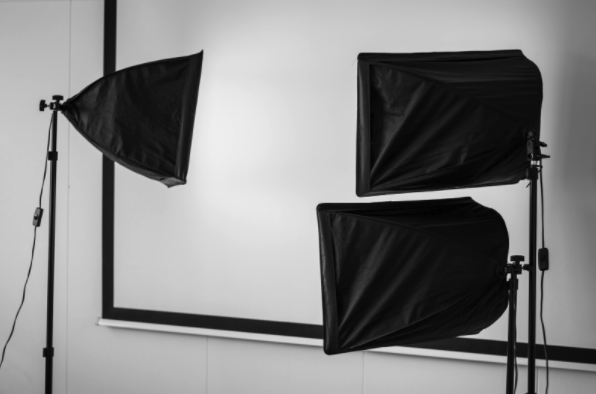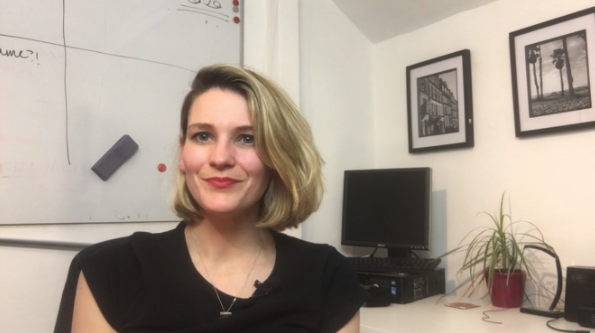Create client onboarding videos that wow your customers

This is our first guest post from Alexandra Bond Burnett, founder trainer and coach at Speaking Ambition.
We recently launched functionality to include videos on your proposals in Ignition, both pre-acceptance and post-acceptance. This was a huge request from our customers, and one we were happy to listen to and incorporate into our product.
But we realise that allowing you to add Loom, YouTube or Vimeo videos to your proposal is one thing, but knowing how to create an engaging video and get your message across is another.
I approached Alexandra and asked her to write a piece that would help our community craft and create better videos that can be used with your clients to win new business and make a personalised impact.
Alexandra is the founder trainer and coach at Speaking Ambition, providing communication coaching for accounting and finance professionals.Not unfamiliar with running a practice, Alexandra is the founder of Blue Arrow Accounting. A forward-facing finance function for SMEs and consultants who take the digital accounting experience and make it human.
A world-class presenter, Alexandra facilitates workshops on creating videos that wow your customers and cut through the noise.
How to create onboarding videos that show your prospects what you're made of
I have great news, and not so great news,
What if I told you that you could easily, creatively and efficiently establish trust in your new client relationships? A way to get them knowing you and liking you, in a smaller time frame?
Sounds amazing, right?
The great news is I can teach you how to do it.
The not so great news is that it requires you getting on camera.
That’s fair.
However, the phrase you must remember in order to push past that discomfort is;
“It’s not about you”
I bought a new car last year. It was on order for a month or so, and I was excited to be getting it; to learn the new gadgets and tech in comparison to my seven year old battered A3 with bits falling off. On the way I received a message with a video… and all it showed me was the car, in the showroom covered up. I couldn’t even see it. My excitement level soared.
Imagine your onboarding experience in a similar way - you want them to be eager and excited to be working with you. They have a swift click by click set up with the Ignition Interface, review the brochure - and then they get a personalised video introducing them into the company. What a welcoming experience.
With video, you give the client a visual and audible taste of what working with you will look like. A great way to set the tone of your relationship at the very start, what to expect and how you operate.
Making your videos
We are visual creatures. That’s why videos are consumed at a rate of knots. Reading text-based information is everywhere, but showing your face or a visual cue develops that face-to-face rapport, digitally.
It gives your clients the essence of who you are. We like seeing people on camera, eye contact, body movements… we feel like we get a sense of who this person is in real life and what they are about.
Here I’m going to give you a step by step guide on how to quickly create onboarding videos that really show your prospects what they are getting when they hit “accept”.
What are you setting out to achieve?
Before you even start a video you need to have a clear idea of what the video is intending to do, and more importantly, how you want the audience to feel.
There are two ways to make videos, and this really depends on what impression you would like to make.
- Make a welcome video for all new clients
- Make an individual video for each prospective client
Or, a mixture of both. There is nothing to say that you cannot embed a welcome video within your proposal, and then send an introduction video from the allocated client manager, after they’ve accepted. Or vice versa.
Actions to take before you start creating video content:
- Who is the video for? Clearly identify the audience, with detail.
- Identify the #1 thing you want your audience to take away from the video
- At the end of the video, what experience should they have had?
Let me show you an example, you are an accounting firm that wants to create a video showing your new client the experience of working with you, and your team.
- The client is the director of a small-sized design agency, with 5 employees. They are afraid of being a small fish in a big pond. They really want an accounting practice that will be proactive in helping them achieve their growth goals.
- The accounting firm would like the design agency to feel confident that their firm will empower them with a listening ear.
- By the end of the video, the agency should acknowledge that the accountants are a great match for them moving forward - feeling assured to make their decision
Getting into a routine of asking these questions will help you quickly create a video that resonates with your ideal client, and save you a lot of messing about.
Write down what your video needs to contain to meet these objectives. Keep it short and sweet - approximately two minutes is the recommended time to keep your viewer’s attention.
Stick to that one take away - don’t overwhelm them from the off. This is purely about showing them the experience of working with you. You can get into details later.
Getting set up
If you are a pro in front of the camera, and Brad Pitt has nothing on your performance skills, then being on camera will be a breeze for you. However, the majority of us end up feeling and looking embarrassingly awkward in front of a lens. Recording can be painful, but not forever.
Remember learning to drive? It was such a pain to have to remember to go through the steps of signalling, checking your mirrors, and getting all the controls working smoothly, Until one day you jumped in the car, and it all just HAPPENED. No thinking about each clunky step, you knew what you were doing. It’s much the same with video!
Here are the steps that will help you make beautiful content easily, without a fuss.
Camera
If you are making individual videos for each proposal, you really want to create your video with a quick turnaround. You only have a couple of options here; a webcam or your phone/camera.
The best thing to do is look through the settings. A high resolution will be sharper and better quality, but a larger file size. My iPhone’s highest resolution is 4k at 30 frames per second (an old 6s) but saves at 350MB for a minute of video.
Phones do have great camera qualities these days, and the quality would still be great with 1080p. You might see a choice between 30 or 60 “fps” This means “frames per second”. If you think that video is simply a series of moving stills, the frames are how many still pictures captured per second. More tends to be better, especially if you’re going to raise the game with some slow-mo action shots.
Webcams can be good but often have poor lighting and positioning as they are set up for ease of using your computer, not for filming awesome proposal videos. Which leads me nicely to...
Lighting
There is no point in filming anything if we can’t see you. Lighting is so important and so often overlooked, We need to see your face. This isn’t the Dark Knight we’re filming here. Professional videographers will tell you about three-point lighting setup, consisting of a key light, a fill light and a backlight.
This is great if you have professional lighting kits but probably not helpful if you’re making content quickly as you go,
DO
- Get plenty of light shining towards your face
- Invest in light boxes or a selfie lighting sticks
- Film near a source of natural light (good excuse to move nearer the window)
DON’T
- Film under down lights or harsh fluorescent lighting, a direct downlight will hollow out your eye sockets and make you look tired by exaggerating the shadows cast on your face.

Positioning
Where you appear on the screen is important, if you’re using a visual tool make the most of it. Think about videos that you’ve been drawn to, where did the person appear on the screen? What makes it easy to watch?
Professionals often will cite the rule of thirds when creating video, which is a grid system that divides the screen into nine equal spaces to help you create more interesting compositions, usually by putting you slightly offside of the center.

That said, new fashions with video calling has put the ‘front and centre of the screen’ shot in vogue.
As long as we have a great experience of you, and your face, with a surrounding of the background, you’ll be on to a winner. The aim is to create a connection with your audience and build familiarity with you, and the office space.



Your voice
Video is a wonderfully visual tool, but the experience of sound will really impact the users brain the most. Clean crisp audio really does make all the difference and makes it easy for us to hear you. You don’t need to spend a fortune on studio-quality microphones, but a good lapel or USB microphone will help capture your voice and reduce any echoes or background noise.
Then the rest is up to you. The trick is to balance your voice as it naturally sounds when
we speak to you face to face. You want to show off the real you, the authentic professional that your clients will meet at a later date.
If you feel awkward on camera you will revert into a rigid scarecrow version of yourself.
When you’re getting started, do a test run, and watch it back. Yes, it will be painful (most people hate watching themselves on screen!) but make this into an assignment and assess:
- Facial expressions
- Hand gestures
- Vocal tone (are you using your natural voice?)
Quick tips for speaking naturally on camera
Tip 1
Loosen all tension from your body. When we feel anxious our bodies tense and that not only affects your body language but also your voice. Stand up, jump up and down, stretch your arms and legs and shake out that tension.
Tip 2
If you’re sitting at your desk, and you’re brain fogs, this will help.
Look down, count to 5 look at the camera… and GO. Speak immediately. You want to give your brain something else to think about and relax your face. Don’t give your brian the time to worry about it. The result of this exercise is a relaxed natural presence that you really want to aim for.
Tip 3
Brains easily remember three things. That’s for you, and the audience. Bullet point the three things you want to get across in the video. Don’t write a script. A script is great for more detailed videos with technical content, but the risk is you’ll end up READING to the camera, and not SPEAKING to the camera.
Tip 4
Simple, but the best tip of all. Remember who you are talking to. Seriously. Visualise them. The lens is a barrier, which can create distance. You need to break through that by really speaking to that person at the other end. Bring the emotion into it that you would feel if you were sitting in front of them.
Put all of these together in your onboarding process, and you will create a powerful user experience that introduces them to your practice.
Most of all, get them knowing you, your firm and what you stand for.
Conclusion
With the changes this year, video communications has soared more than it already has.
Jonathan Bareham of Raedan accountants has been using Loom as a great way to answer client questions AND build up knowledge assets in their practice.
“We got into the habit of replying to client emails using a loom. We’d only end up going back and forth anyway and then answering with a phone call, so the videos went down really well as the client can go through it step by step. No one gets praise from an email, but we did from our videos!”
Happy filming everyone.
Alexandra is the founder trainer and coach at Speaking Ambition.
Alexandra is also the founder of Blue Arrow Accounting. A forward-facing finance function for SMEs and consultants. Taking the digital accounting experience and making it human.
Alexandra is a world-class presenter and facilitates workshops on creating videos that wow your customers and cut through the noise.
